Animated Series
Vulcans
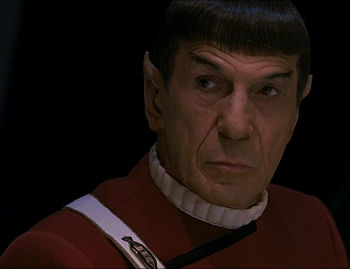
Spock, Vulcan male (ST-06)
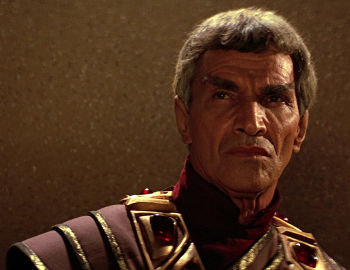
Sarek, Vulcan male (ST-03)
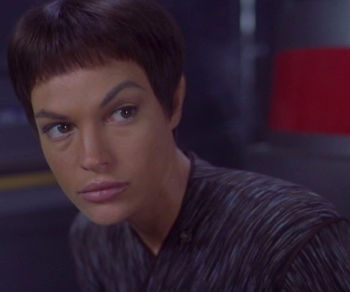
T’Pol, Vulcan female (ENT-22)
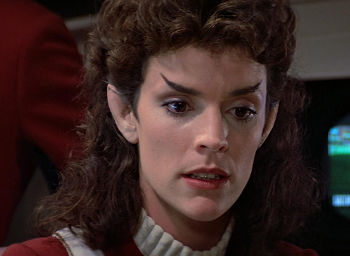
Saavik, Vulcan female (ST-03)
Species originating on Vulcan,[3] Vulcans were dedicated to a philosophy of emotional suppression in favor of total logic.[2]
References
- 1. “The Cage.” Star Trek, Episode 00. Television. 1965 (Unaired).
- 2. “Mudd’s Women.” Star Trek, Episode 03. Television. 13 October 1966.
- 3. “Amok Time.” Star Trek, Episode 34. Television. 15 September 1967.
- 4. “Journey to Babel.” Star Trek, Episode 44. Television. 17 November 1967.
- 5. “The Savage Curtain.” Star Trek, Episode 77. Television. 7 March 1969.
- 6. Star Trek II: The Wrath of Khan. Film. 4 June 1982.
- 7. “Broken Bow.” Star Trek: Enterprise, Episodes 01-02. Television. 26 September 2001.
Klingons
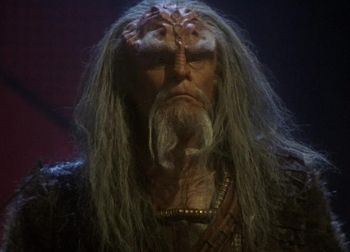
Chancellor Mirek (ENT-01-02)
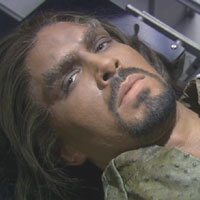
Marab (ENT-92)
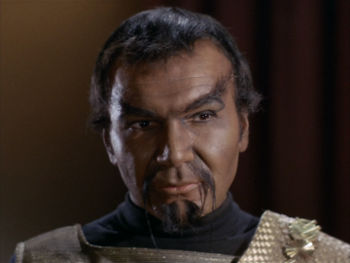
Kor (TOS-27)
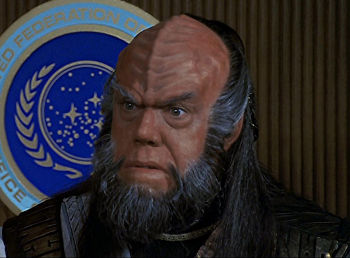
Klingon Ambassador (ST-06)
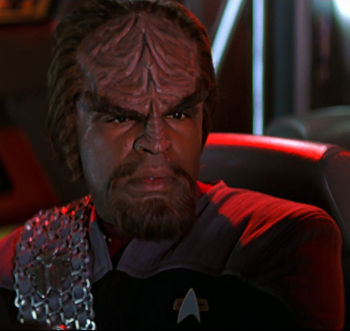
Worf (ST-09)
A humanoid, mammalian warrior society[1] from the planet Qo’noS (often transliterated as Kronos),[9] Klingons first encountered Humans in 2151, when a Klingon courier crash-landed on Earth.[20]
› Continue reading
Starfleet Command

Starfleet Command (ST-04)
The operating authority for Starfleet,[1] Starfleet Command was based out of San Francisco on Earth,[2] though command facilities were also located on major worlds and starbases throughout Federation space.[3] The Chief of Starfleet Operations oversaw a staff of admirals, each responsible for a specific region or division.[4]
References
- 1. “Court Martial.” Star Trek, Episode 15. Television. 2 February 1967.
- 2. Star Trek IV: The Voyage Home. Film. 26 November 1986.
- 3. The Star Trek Encyclopedia. Book. 1997 (rev. ed.). Pocket Books.
- 4. “Core Game Book.” Star Trek: The Next Generation Role Playing Game, Book 25000. Game. August 1998. Last Unicorn Games.
U.S.S. Enterprise NCC-1701
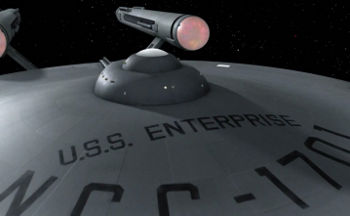
U.S.S. Enterprise (TOS-61)
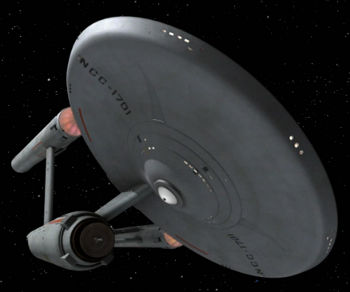
Constitution class (TOS-10)
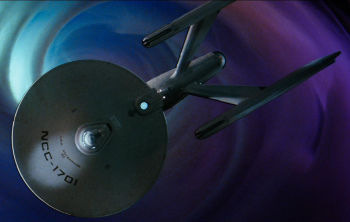
U.S.S. Enterprise (ST-2)
Perhaps the most famous spacecraft in the history of space exploration, the U.S.S. Enterprise NCC-1701 was a Constitution class vessel.[3] Launched in 2245[13] from the San Francisco Fleet Yards orbiting Earth,[1] the Enterprise was first commanded by Captain Robert April,[4] who was later succeeded by his first officer, Christopher Pike, in 2250.[9] During Pike’s command, the Enterprise had a crew complement of 203, though it was unclear if this figure included Pike himself.[1] According to Ensign Tyler, the ship’s power was “enough to blast half a continent.”[1] Superbly equipped for research in deep space, the Enterprise had 14 science labs.[2] The ship achieved legendary status during the first five-year mission under its third captain, James T. Kirk, from 2265 to 2270.[5]
› Continue reading
Constitution Class
Original Configuration

Constitution class (TOS-10)
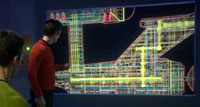
Constitution class MSD (ENT-95)
| Length | 289 meters |
| Width | 127 meters |
| Height | 73 meters |
| Decks | 23 |
| Mass | Mk. I: 162,425 metric tons Mk. II: 164,400 metric tons Mk. III: 167,900 metric tons |
| Crew Complement | 430 |
| Evacuation Limit | 320 |
| First Commissioned | 2245 |
| Weapons | 6 Type-V phaser banks, 2 torpedo launchers, photon torpedoes |
| Defenses | Deflector shields |
| Cruising Speed | Warp 6 |
| Maximum Cruise Speed | Warp 7 |
| Maximum Rated Speed | Warp 8 for 12 hours |
Refit Configuration
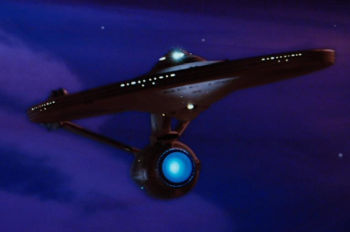
Constitution class refit (ST-02)
| Length | 305 meters |
| Width | 131 meters |
| Height | 74 meters |
| Crew Complement | 416 |
| Evacuation Limit | 240 |
| First Commissioned | 2273 |
| Weapons | 12 Type-VI phasers in 6 banks; 3 torpedo launchers, photon torpedoes |
| Defenses | Deflector shields |
| Cruising Speed | Warp 6 |
| Maximum Cruise Speed | Warp 8 |
| Maximum Rated Speed | Warp 10 for 12 hours |
The Constitution class cruisers are among the most renowned vessels of their time. Serving as both a research vessel and a cruiser, these ships performed their duties to perfection for the majority of the 23rd century. The Constitution class ships were an integral part of the buildup during “The Great Awakening,” from the outset the most versatile of all ships built for the expansion efforts. class starships included the acclaimed U.S.S. Enterprise NCC-1701.[1] During the time of Captain James T. Kirk’s celebrated first five-year mission of exploration, only twelve of these ships were in existence.[2] Constitution class starships used duotronic computers, based on designs developed by Dr. Richard Daystrom in 2243.[8]
› Continue reading
Vulcan
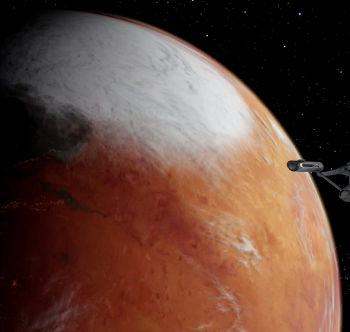
Vulcan (TOS-34)
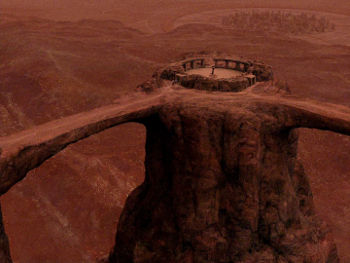
Vulcan surface (TOS-34)
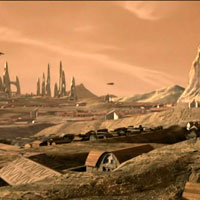
Vulcan surface (ENT-79)
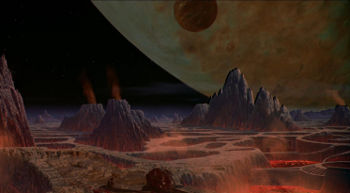
Vulcan Surface (ST-01)

Vulcan Surface (ST-01)
Vulcan, a Class-M world,[2, 4] was the second planet in the 40 Eridani trinary system, orbiting 40 Eridani A.[4] Although Vulcan had no moon,[1] the planet shared an orbit with its sister world, T’Khut.[3]
› Continue reading
Earth
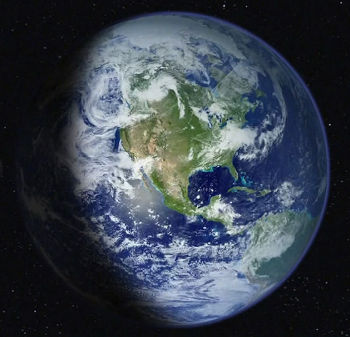
Earth (TOS-21)

Earth (ENT-78)
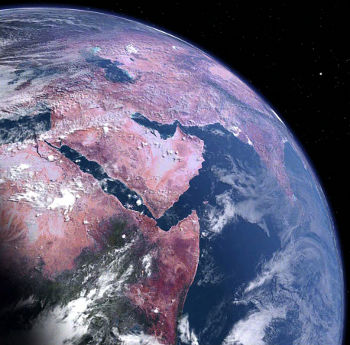
Earth (TOS-55)
Class-M. Earth is the third planet in the Sol System[1] in Sector 001[7] and homeworld of Humans. In 2254, the Talosians viewed an image of the Sol System and many images of Earth’s history while accessing the U.S.S. Enterprise NCC-1701‘s computer.[1] Earth became one of the founding members of the United Federation of Planets in 2161,[15] following the Romulan War,[6] and served as that body’s capital.[5] Starfleet Command and Starfleet Academy were based in San Francisco,[2, 3] while the offices of the Federation President[9] and the Federation Council chamber were located in Paris.[22] The planet hosted several advanced orbital habitats,[2] Starfleet spacedocks,[4] and satellite networks, including Federation communications networks.[12]
› Continue reading
Planet, Class-O
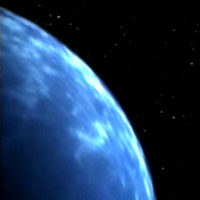
Pacifica (TNG-145)

Class-O Planet (ENT-56)
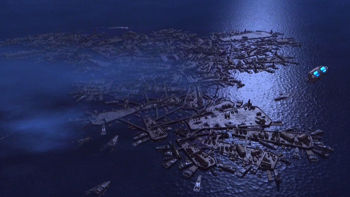
Class-O Planet Surface (ENT-56)
Pelagic. Age ranged from 3-10 billion years. Diameter was 10,000 to 15,000 km. Typically located in the Ecosphere of a planetary system. Liquid water covered 80% or more of the surface area, atmosphere consisted of nitrogen, oxygen, and trace elements. May have contained aquatic vegetation, animal life, and possibly humanoids.[1]
References
- 1. Star Trek: Star Charts. Book. 2002. Pocket Books.
Planet, Class-M

Earth (ENT-78)

Vulcan (TOS-34)
Terrestrial. Age ranged from 3-10 billion years. Diameter was 10,000 to 15,000 km. Typically located in the Ecosphere of a planetary system. Surface water was abundant; if water or ice covered more than 80% of the surface, the planet was considered Class O or Class P. Atmosphere was primarily primarily nitrogen, oxygen, and trace elements. Contained extensive vegitation and animal life.[8] Capable of supporting carbon-based, humanoid life.[1]
The designation apparently stemmed from the Vulcan word “Minshara,” which was used to designate planets capable of supporting life.[7] Class-M planets could vary widely in color, cloud cover, and overall appearance. Most Class-M planets were characterized by a relatively thin, tectonically active crust floating on a molten rock mantle, which in turn surrounded a liquid metal outer core and a solid inner core composed of metal crystals.
› Continue reading
Quadrants

One quarter of the galaxy. The four quadrants were designated by the Greek letters Alpha, Beta, Gamma, and Delta, and were arbitrarily divided using Earth as a reference point. As a result, Earth, and the sector it occupied, fell in the Alpha Quadrant, while the sector containing Vulcan and Andoria fell in the Beta Quadrant. The Gamma and Delta Quadrants remained largely unexplored through the 25th century, though knowledge of those regions was greatly increased thanks to the Bajoran wormhole and the U.S.S. Voyager NCC-74656, respectively.[1]
› Continue reading
Categories
- Animated Series (60)
- Articles (28)
- Books (447)
- Cast & Crew (79)
- Comics (22)
- DS9 (328)
- Early Voyages (125)
- Education (5)
- Enterprise (373)
- Excelsior (36)
- Food (19)
- Games (223)
- Klingon (70)
- Library (1,543)
- Logs (593)
- Lost Era (55)
- Medicine (18)
- Merrimac (1)
- Mirror (35)
- Miscellaneous (13)
- New Frontier (54)
- Next Generation (635)
- Original Series (681)
- Personnel (436)
- Places (369)
- Politics (12)
- Recreation (10)
- SCE (41)
- Science (1)
- Shatnerverse (9)
- Ships (455)
- Site Updates (98)
- Starfleet Academy (86)
- Stargazer (42)
- STO (61)
- Technology (45)
- Titan (59)
- To Boldly Go (1)
- TV/Film (214)
- Uncategorized (4)
- Vanguard (76)
- Voyager (236)
- Weapons (27)
- Xenology (54)